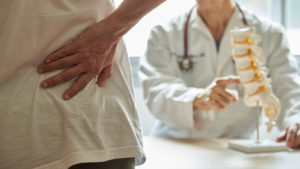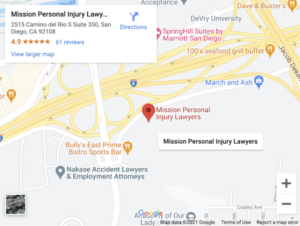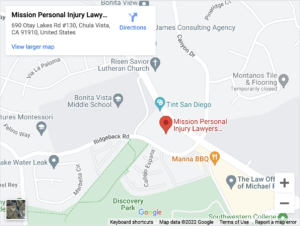
Your back serves so many critical functions that a back injury can rob you of the ability to work or even perform necessary tasks like showering or dressing. Back injuries are the top reason for missed workdays. They are also the most common on-the-job injury.
This makes sense. Your back carries your head and upper body. Without a healthy back, you cannot stand, sit, walk, or carry objects. At night, you might not even find a comfortable position to sleep.
Here is an overview of the causes and effects of a back injury and the compensation you can seek.
Table of Contents
What Structures Are in Your Back?
Your back is part of your musculoskeletal system. It includes bones and muscles to support and move your body. It also includes connective tissue to give your back structure and flexibility.
Bones
The spine sits in the center of your back. The spine includes 24 vertebrae. Each vertebra includes a cylindrical body and wing-shaped processes.
The body provides support. When the vertebrae align, the bodies form a solid column that carries the weight of your upper body and head.
The processes provide an anchor point for connective tissues. The gap between the body and the processes forms the spinal canal.
Your ribs protect the heart and lungs in your chest. The ribs fit into your vertebrae to form a flexible joint.
Ligaments
Ligaments hold bones together at joints. In your back, ligaments connect the vertebrae. These ligaments hold the vertebrae in place so that your vertebrae do not dislocate and injure your spinal cord. They also provide the flexibility that allows your muscles to bend and twist your back.
Muscles and Tendons
Muscles provide movement and strength to your back. Tendons anchor muscles to bones. Muscles and tendons connect your spine, skull, and shoulder blades. They also sit between your ribs.
Together, the muscles and tendons provide the motion that allows you to breathe, stand, bend, turn, lift, and carry.
How Does a Back Injury Happen?
Back injuries happen in many ways. Trauma from an accident can come in many forms, including:
Hyperextension
Many back injuries result from hyperextending your back. Hyperextension happens when a force stretches your back beyond its normal limits.
Car accidents can hyperextend your back. When you collide with something, your body wants to keep moving at the same speed and direction as before the collision. This inertia causes your body to bend at the moment of impact. This hyperextends your back.
Your seat belt catches your body, causing it to stop suddenly. As your body comes to a stop, your back compresses.
The whipping motion that causes your spine to hyperextend and compress can damage your muscles, tendons, ligaments, discs, and vertebrae.
Blunt Impact
A blunt impact happens when a force strikes your back without penetrating it. In a slip and fall accident, falling onto your back will cause a blunt impact.
Penetrating Impact
A penetrating impact happens when an object strikes your back and pierces it. For example, if a piece of rebar pierced your back in a construction accident, you suffered a penetrating injury.
What Types of Back Injuries Can Occur?
Back injuries take many forms depending on the structures that suffer damage. Some common back injuries include:
Strained or Sprained Back
Your muscles, tendons, and ligaments can get stretched or torn when your back hyperextends. When the muscles or tendons get stretched or torn, you suffer a strained back.
Symptoms of a strained back include:
- Pain
- Inflammation
- Stiffness
- Weakness
- Muscle spasms
When the ligaments get stretched or torn, you suffer a sprained back. A characteristic symptom of a sprained back is a popping sound or feeling when you injured your back.
Other symptoms of a sprained back include:
- Pain
- Inflammation
- Instability
- Bruises
- Limited range of motion
In most cases, a strained or sprained back will heal without surgery in four to six weeks. Doctors will recommend icing the injury and resting your back. This may require you to miss work, limit your work hours, or take light duty.
Dislocated Rib
Ligaments hold your ribs to your spine. When these ligaments get stretched or torn, your rib can dislocate out of the joint with your spine.
Symptoms of a dislocated rib include:
- Pain while breathing
- Swelling
- Limited range of motion
A dislocated rib rarely requires surgery. Instead, the doctor will try to reduce the swelling so the rib can slip back into place. A doctor will likely prescribe rest, ice for the injury, and anti-inflammatory drugs.
Fractured Rib
A blunt impact on your back can break a rib. A fractured rib will produce pain, bruises, and swelling. Doctors no longer tape or wrap your back when you suffer a fractured rib because the limited motion while breathing can lead to pneumonia.
The biggest risk from a fractured rib is not the broken bone. Instead, the jagged edge of the broken rib can pierce your pleural lining or lung. This can damage your lung or even cause the lung to collapse.
Damaged Disc
The discs have a tough outer annulus and a gel-like nucleus. Compression of the discs can weaken the annulus. If the annulus separates, the nucleus can protrude from the disc, causing a herniated disc. If the annulus weakens, it can sag and bulge, causing a bulging disc.
In both cases, the deformed disc can pinch nerves causing nerve damage.
Symptoms of nerve damage from a damaged disc include:
- Pain
- Numbness or tingling
- Weakness
- Loss of dexterity
Doctors cannot repair a damaged disc. But they can replace it with an artificial disc or remove it and fuse the vertebrae.
Fractured Vertebra
A fractured vertebra is the most serious back injury you can suffer. Bone fragments from a fractured vertebra can dislocate into the spinal canal and sever the spinal cord. When this happens, you will suffer permanent paralysis.
What Compensation Can I Get for a Back Injury?
When you suffer a back injury due to the negligent or intentional actions of another, you can seek injury compensation. This compensation will cover your economic and non-economic losses.
Economic losses include your medical expenses, lost income, and diminished earning capacity from long-term disabilities. Your non-economic losses include your physical pain, mental suffering, and inability to participate in activities.
Back injuries can affect your ability to work and reduce your quality of life. To discuss the compensation you might seek for your back injury, contact Mission Personal Injury Lawyers for a free consultation with our personal injury attorneys in San Diego, CA.


